August 2010 LIP of the Month
The Willouran-Guibei Large Igneous Province (LIP): Dismembered During the Breakup of the Supercontinent Rodinia?
Xuan-Ce Wang1,2,3, Zheng-Xiang Li1, Xian-Hua Li2
1 The Institute for Geoscience Research (TIGeR), Department of Applied Geology, Curtin University, GPO Box U1987, Perth, WA 6845, Australia; X.Wang3@curtin.edu.au; Z.Li@exchange.curtin.edu.au
2 State Key Laboratory of Lithospheric Evolution, Institute of Geology and Geophysics, Chinese Academy of Sciences, P.O. Box 9825, Beijing 100029, China; lixh@gig.ac.cn
3 School of Earth and Environment, the University of Western Australia, Crawley, WA 6009, Australia
Introduction
Mantle plume activity has commonly been invoked as a cause of the breakup of Rodinia (Ernst et al., 2008; Li et al., 1999, 2002, 2003a, b, 2008; Li and Zhong, 2009; Park et al., 1995; Wang et al., 2007, 2008, 2009, 2010a). South and Central Australia, and the South China Block, have some of the best-preserved records of ca. 825 Ma plume events that include large igneous provinces (LIPs) with high-T lavas, large-scale syn-magmatic doming and associated continental rifting (e.g., Li et al., 2008 and references therein). However, the possible inter-relationship between the events recorded by the two continents has not been rigourously tested.
The Willouran Basic Province (LIP) in South and Central Australia, and the Guibei LIP in the South China Block are two of the most prominent Neoproterozoic LIPs formed during the breakup of the supercontinent Rodinia (e.g., Ernst et al., 2008; Li et al., 2008; Wang et al., 2010a). If Australia and South China Block were indeed adjacent to each other in Rodinia as proposed by Li et al. (1995, 1999, 2003b, 2008), the LIPs now preserved in both continents could be cogenetic.
The ca. 825 Ma Willouran LIP, South-Central Australia
The Willouran Basic Province (LIP) is dominated by tholeiitic mafic dykes (e.g., Gairdner Dyke Swarm), continental flood basalts (e.g., the Wooltana Volcanics, the Beda Volcanics, the Deport Creek Volcanics and the Bitter Springes Volcanics) and mafic intrusions (e.g., Little Broken Hill Gabbro) that spread across the Gawler Craton, the Adelaide Rift Complex, the Musgrave Block, and the Amadeus Basin (e.g., Crawford and Hilyard, 1990; Ernst et al., 2008; Hilyard, 1990; Wang et al., 2010a; Wingate et al., 1998; Zhao et al., 1994) (Fig. 1). Geochemical, petrographic, and stratigraphic work (e.g., Crawford and Hilyard, 1990; Wang et al., 2010a; Zhao et al., 1994) demonstrate that the Willouran LIP has features similar to more recent large igneous provinces such as the Columbia River, Parana, and Deccan continental flood basalt provinces.
The age of intrusive magmatism in the Willouran LIP is constrained by SHRIMP U-Pb zircon ages for the Gairdner Dyke Swarm (827 ± 6 Ma; Wingate et al., 1998), the Amata dykes (824 ± 4 Ma; Sun, S-s., unpublished data in Glikson et al., 1996) and the Little Broken Hill Gabbro (827 ± 9 Ma; Wingate et al., 1998) (Figs. 1 and 2). Geochemical analyses and stratigraphical comparisons suggest that the extrusive components and the intrusive components within the Willouran LIP were comagmatic (Wang et al., 2010a and references therein). Therefore, the eruptive age for the flood basalts (e.g., the Wooltana Volcanics) is estimated at ca. 825 Ma (e.g., Preiss, 2000; Foden et al., 2002; Wang et al., 2010a; Wingate et al., 1998) (Fig. 2). The minimum eruptive age for flood basalts in the Willouran LIP is constrained by the 802 ± 10 Ma U-Pb zircon age for the Rook Tuff in the upper Willouran sediments that overlies the Wooltana Volcanics (Fanning et al., 1986; Fig. 2). Collectively, these results demonstrate that intrusive and extrusive rocks in the Willouran LIP are likely to have formed between ca. 830 and 800 Ma (Wang et al., 2010a; Fig. 2).
Although it has long been recognized that the Willouran LIP was likely the product of a mantle plume (e.g., Crawford and Hilyard, 1990; Ernst et al., 2008; Hilyard, 1990; Li et al., 2008; Wingate et al., 1998; Zhao et al., 1994), the position of the plume head remains an open question. Li et al. (1999, 2008) proposed that the plume head was located beneath the South China Block, once sitting east of cratonic Australia.
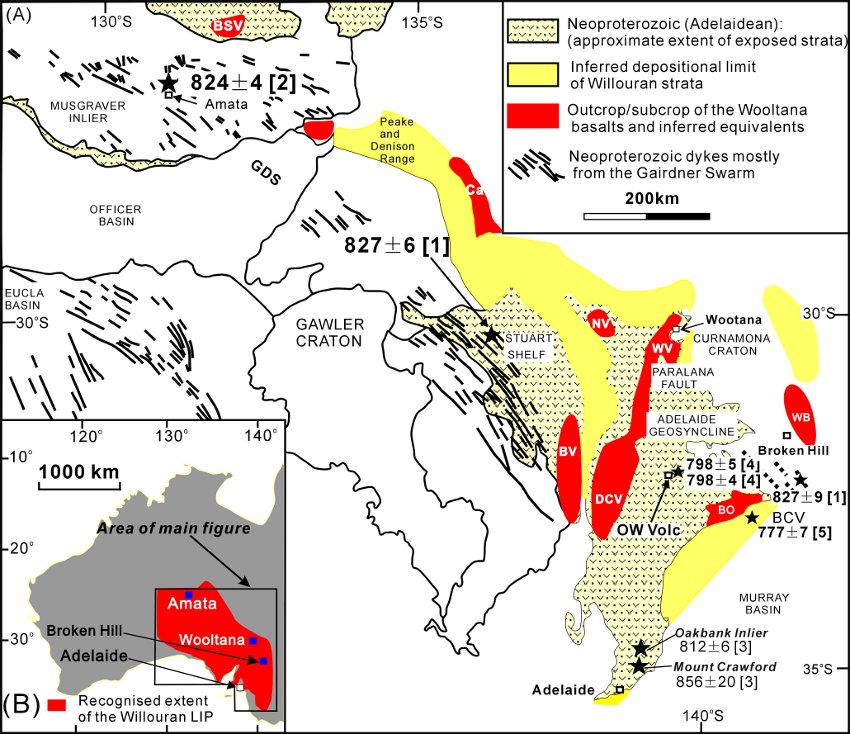
Figure 1. Simplified geological map of the Neoproterozoic Willouran Basic Province (LIP) (after Crawford and Hilyard, 1990; Wingate et al., 1998; Wang et al., 2010). Inset (B) shows the regional extent of the Willouran LIP.
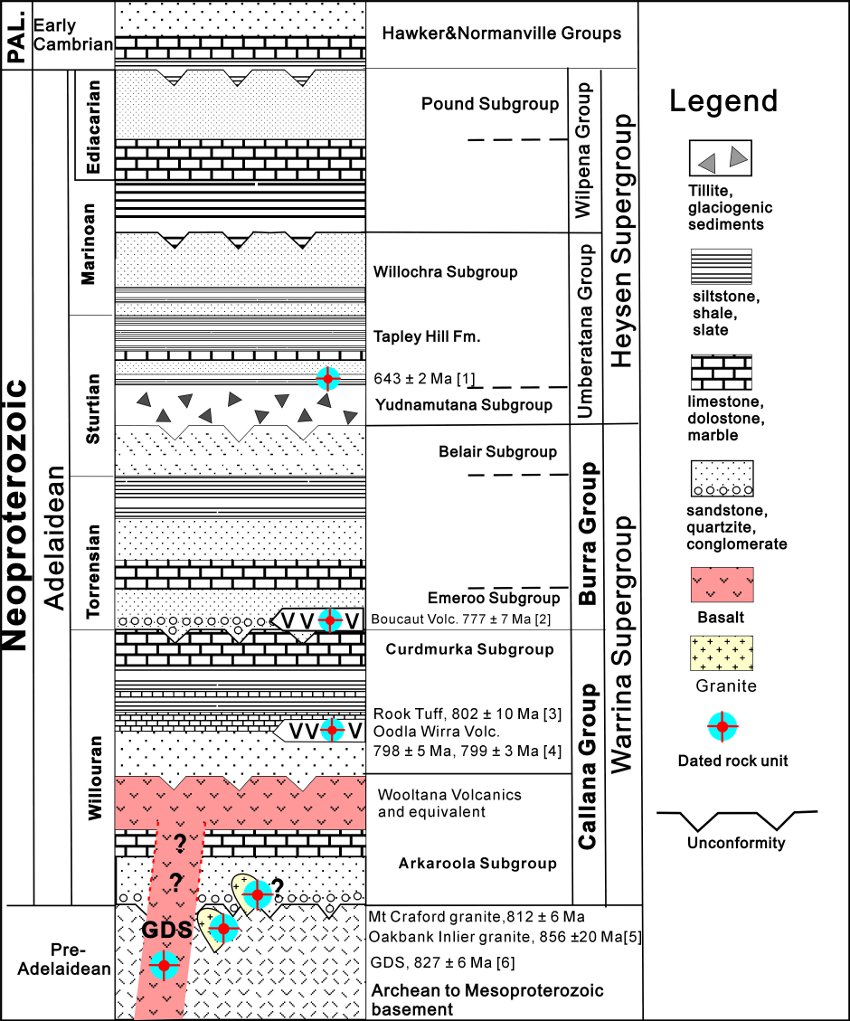
Figure 2. Schematic composite stratigraphy for Neoproterozoic rocks in the Adelaide Rift Complex and adjacent platforms (after Wingate et al., 1998; Wang et al., 2010a).
The basaltic suites in the Willouran LIP, spread across a distance of more than 1000 km including the Gairdner Dyke Swarm (GDS), the Wooltana Volcanics (WV), the Deport Creek Volcanics (DCV), the Bitter Springs Volcanics (BSV) and the Beda Volcanics (BV) have identical average major element compositions: ~51 wt.% SiO2, ~1.6 wt.% TiO2, 14 wt.% Al2O3 and ~12 wt.% FeOT (Wang et al., 2010 and references therein). Together with their uniform trace element distribution patterns (Fig. 3) and similar Nd isotopic compositions (Fig. 4), the basaltic suites were most likely derived from a common mantle source at similar melting conditions, and underwent insignificant crustal contamination (Wang et al., 2010a).
The nature of the mantle source can be constrained by Figures 5 and 6. The correlations imply that these basalts were likely derived from mixing of depleted and enriched end-member melts. The enriched end-member melts could be derived mainly from recycled oceanic crust or entrained lower mantle materials (Wang et al., 2010a).
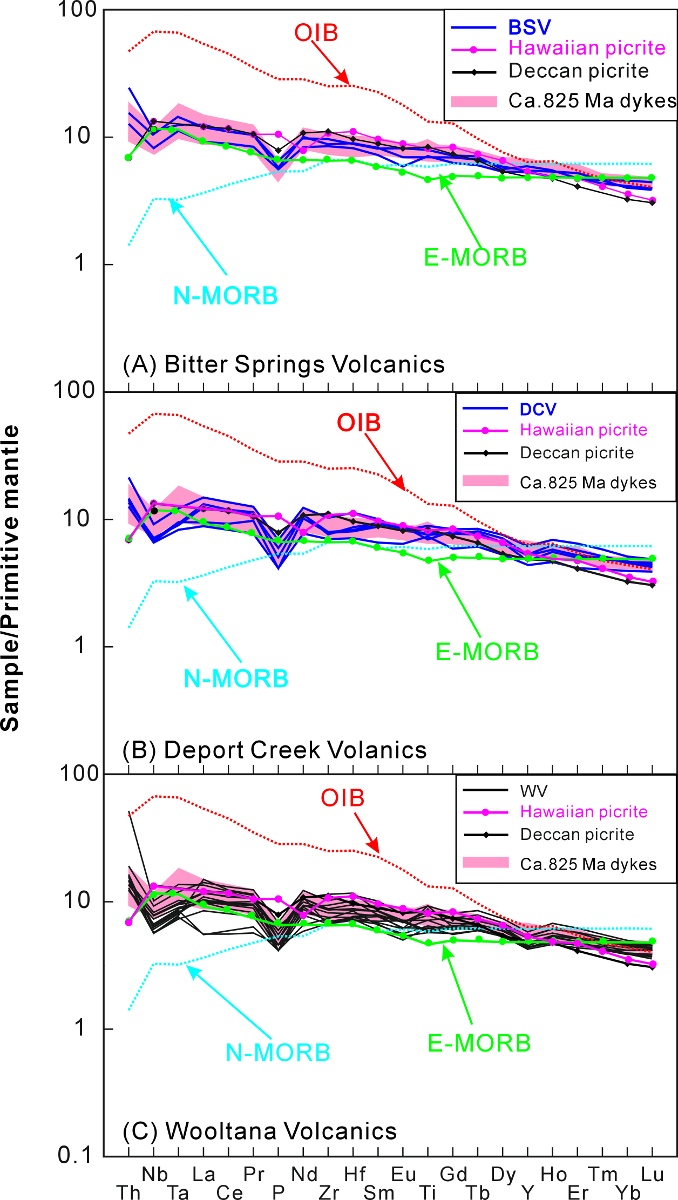
Figure 3. Primitive mantle-normalized incompatible trace element spidergrams for (A) Bitter Spring Volcanics, (B) Deport Creek Volcanics; and (C) Wooltana Volcanics (Wang et al., 2010a).
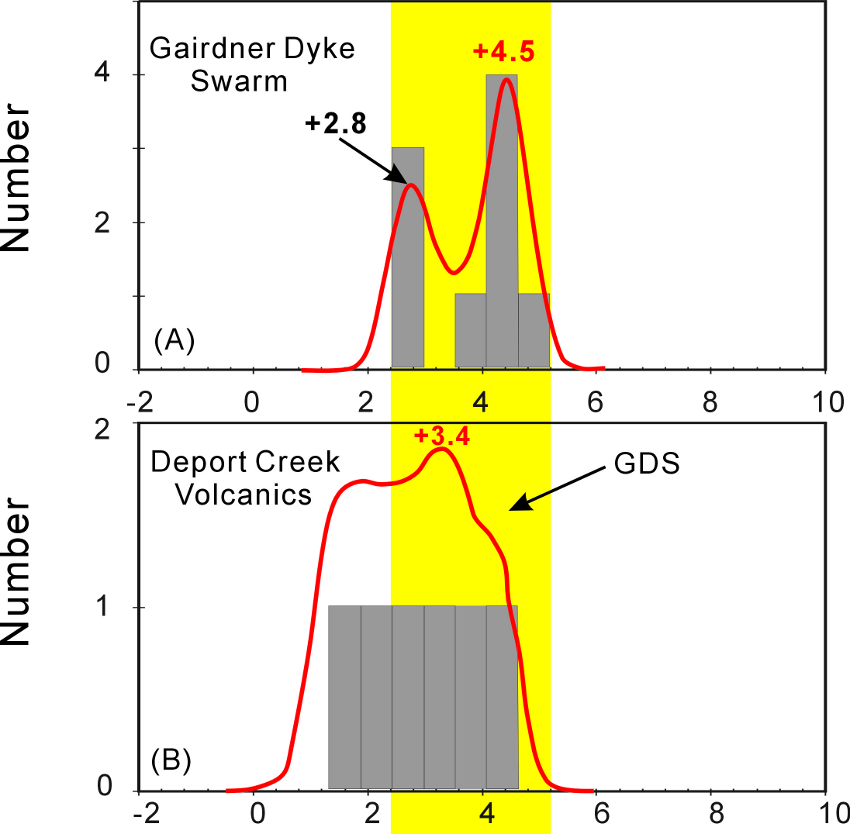
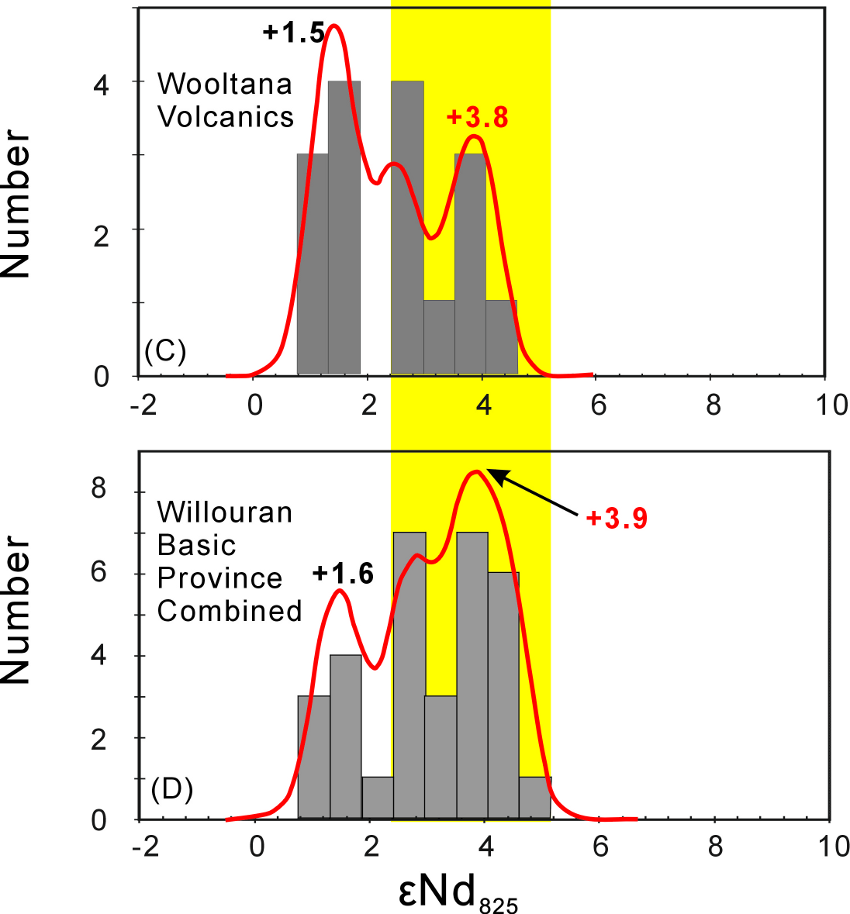
Figure 4. Histograms for Nd distributions of (A) the Gairdner Dyke Swarm, (B) the Deport Creek Volcanics, (C) the Wooltana Volcanics, (D) the Willouran LIP combined data (after Wang et al., 2010a).
The ca. 825 Ma Guibei LIP, South China
The Guibei LIP comprises products of major bimodal magmatic events in South China, including the 830-810 mafic-ultramafic dykes and intrusive complexes, remnants of 825-810 Ma continental flood basalts (the Bikou-Tiechuasnahn tholeiites), 826 ± 3 Ma high-Mg basalts, sporadic ca. 825 Ma basalt outcrops and numerous synchronous granitic intrusions in both the interior and along the margin of the South China Block (Ernst et al., 2008 and see recent update at http://www.largeigneousprovinces.org/09may).
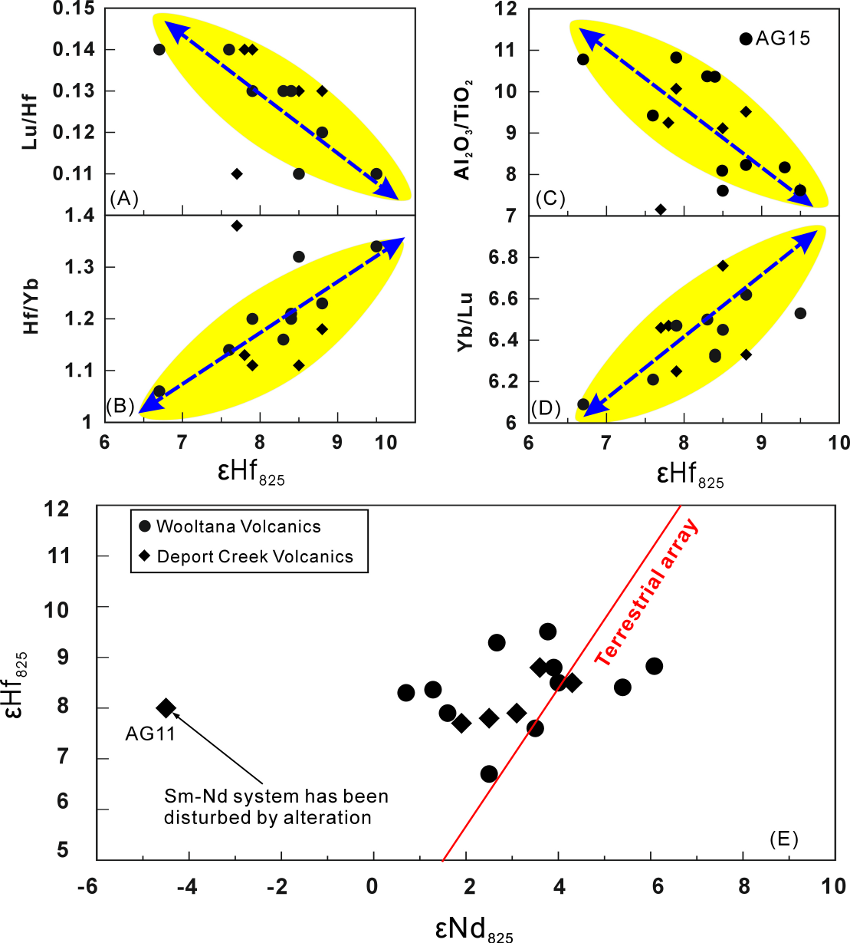
Figure 5. Plots of (A) Lu/Hf, (B) Hf/Yb, (C) Al2O3/TiO2, and (D) Yb/Lu vs. εHf825 (Wang et al., 2010a).
A mantle plume origin for the Guibei LIP was based on a number of geological, geochemical and geochronological observations, such as evidence for widespread occurrence of anorogenic magmatism with rock types ranging from granite to mafic–ultramafic dykes and sills (implying the presence of mafic underplating and a large heat source), large-scale syn-magmatic doming, the development of ca. 820 Ma continental rift systems (Li et al., 2008 and references therein), and importantly, the recent identification of the 823 ± 6 Ma high-temperature Yiyang komatiitic basalts (Wang et al., 2007). The syn-magmatic doming and coeval high-T lavas indicate that a ca. 825 Ma plume-head was located beneath South China.
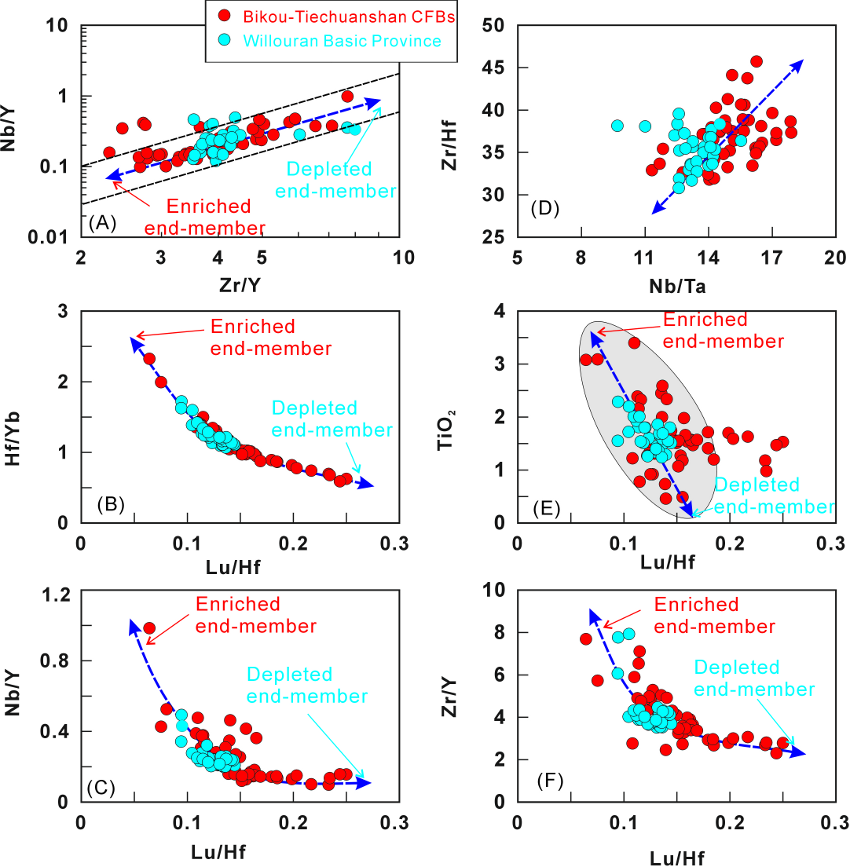
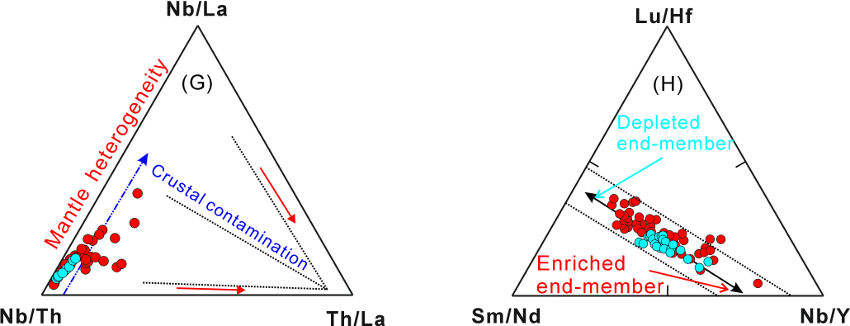
Figure 6. Comparative plots of (A) Nb/Y vs. Zr/Y, (B) Hf/Yb vs. Lu/Hf, (C) Nb/Y vs. Lu/Hf, (D) Zr/Hf vs. Nb/Ta, (E) TiO2 vs. Lu/Hf , (F) Zr/Y VS. Lu/Hf, (G) Nb/la- Nb/Th-Th/La, and (H) Lu/Hf-Sm/Nd-Nb/Y for the Bikou-Tiechuanshan continental flood basalts and the Willouran LIP (after Wang et al., 2010a).
We note that Zhou and coworkers have proposed an arc model for the Neoproterozoic igneous rocks in South China (e.g., Zhou et al., 2002, 2006). Their main evidence for this stems from the depletions of Nb, Ta and Ti found in some of the igneous rocks, mostly in granitoids (Zhou et al., 2002). However, it has been argued that arc-like geochemical signatures in continental felsic rocks should not be used as diagnostic indicators for subduction settings because such signatures are often inherited from the source rocks (e.g., Wang et al., 2009; Li et al., 2006). The subduction model is also inconsistent with a number of other geological, geochemical and petrological observations in the region such as a regional structural trend in western South China Block that is at high angle to that predicted by the arc model, the large distances between many of the plutons and the then continental margins, the close temporal and spatial links between plutonism and continental rifting, and extremely H2O-poor but high-T melt conditions (e.g., Li et al., 2006, 2007, 2009; Wang and Li, 2003; Wang et al., 2007, 2008, 2009, 2010a, b).
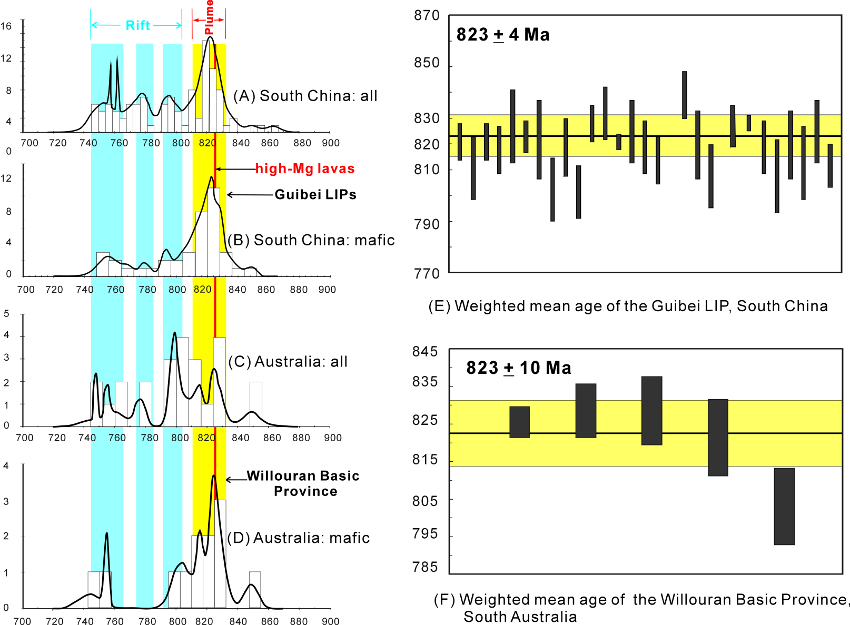
Figure 7. Age distribution of igneous rocks in South China and South Australia between 850 and 750 Ma (after Wang et al., 2010a).
Geodynamic model: Parts of a dismembered large igneous province (LIP) associated with the breakup of Rodinia?
Figure 7 plots all available Neoproterozoic magmatic ages from the South China Block and South-Central Australia. The age distribution of Neoproterozoic magmatism in the South China Block (Fig. 7A) matches well with that of South-Central Australia (Fig. 7C). Figure 7 shows that mafic magmatism in South China occurred mainly between 830 and 810 Ma (the age span for the Guibei LIP; e.g., Li et al., 2008; Ernst et al., 2008), which is comparable to that of the Willouran LIP (highlighted in yellow in Fig. 7). The two LIPs have the same peak age of ca. 823 Ma, which is identical to the 823 Ma age for the high-temperature Yiyang komatiitic basalts in central South China (Wang et al., 2007). Furthermore, the flood basalts from the two regions share similar trace element compositions (Wang et al., 2010a; Fig. 6), implying that basalts from the two LIPs most likely derived from a common mantle source and involved both enriched and depleted end-members. Together with previous tectonostratigraphic studies (Li et al., 1995, 1999, 2008), these similarities suggest that (1) the Adelaide Rift Complex and the Bikou-Hannan Rift may have been part of a triple-junction rifting system with the Adelaide Rift Complex being a failed rift; and (2) the synchronous LIP events in the South China Block and in the South and Central Australia may represent the dismembered parts of a single LIP, termed the Willouran-Guibei large igneous province, that formed during the breakup of the supercontinent Rodinia (Fig. 8A).
Figure 8B illustrates our revised geodynamic model for the generation of the 830-810 Ma large igneous province, the Willouran-Guibei LIP that spread across South China and southern Australia. A mantle plume is suggested to have impinged at the base of the continental lithosphere beneath the Yangtze craton at ca. 830 Ma. The initial phase of the LIP event may have occurred at ca. 830 Ma and peaked at ca. 825 Ma, followed by continental rifting. The Yangtze cratonic keel would have deflected the plume head to two major pre-existing lithospheric weak zones, one being between the Yangtze and Australian cratons, the other being the Sibao orogen between the Yangtze and Cathaysia cratons, both leading to the intrusion or eruption of LIP magmatism and continental rifting (Fig. 8). The uprising plume may be channelled along weak zones or "thin spots". The "thin spot" extended all the way from central South China Block, through northern Yangtze Craton, to South and Central Australia.
Note that the Guibei LIP is characterised by the existence of some high-Mg melt compositions (as high as 20 wt.% MgO) as suggested for the Yiyang pillowed lavas in central South China (Wang et al., 2007). Such high-Mg melts compositions predict an anomalously hot mantle source with potential temperature (Tp) 260 ± 50 °C higher than the ambient asthenospheric mantle, which in turn requires a large heat source that can really only be attained by rapid uprise of vigorous plumes from depth. These high temperature magmas have the excess thermal energy that can initiate melting of both lower and upper crustal rocks or even the lithospheric mantle. This could explain the widespread granitic magmatism that covers an area of more than 1000×700 km2 (Li et al., 2003a) in the Guibei LIP within a few million years of the emplacement of the high-temperature lavas. The high temperature, plus the plume-led doming, can also soften and thin the continental crust, leading to continental rifting and breakup. Dyke swarms formed in such an environment are expected to be short and with multiple strike directions, as we observe in South China. In short, all observations indicate that the plume center was located right beneath South China rather than Australia, as first proposed by Li et al. (1999).
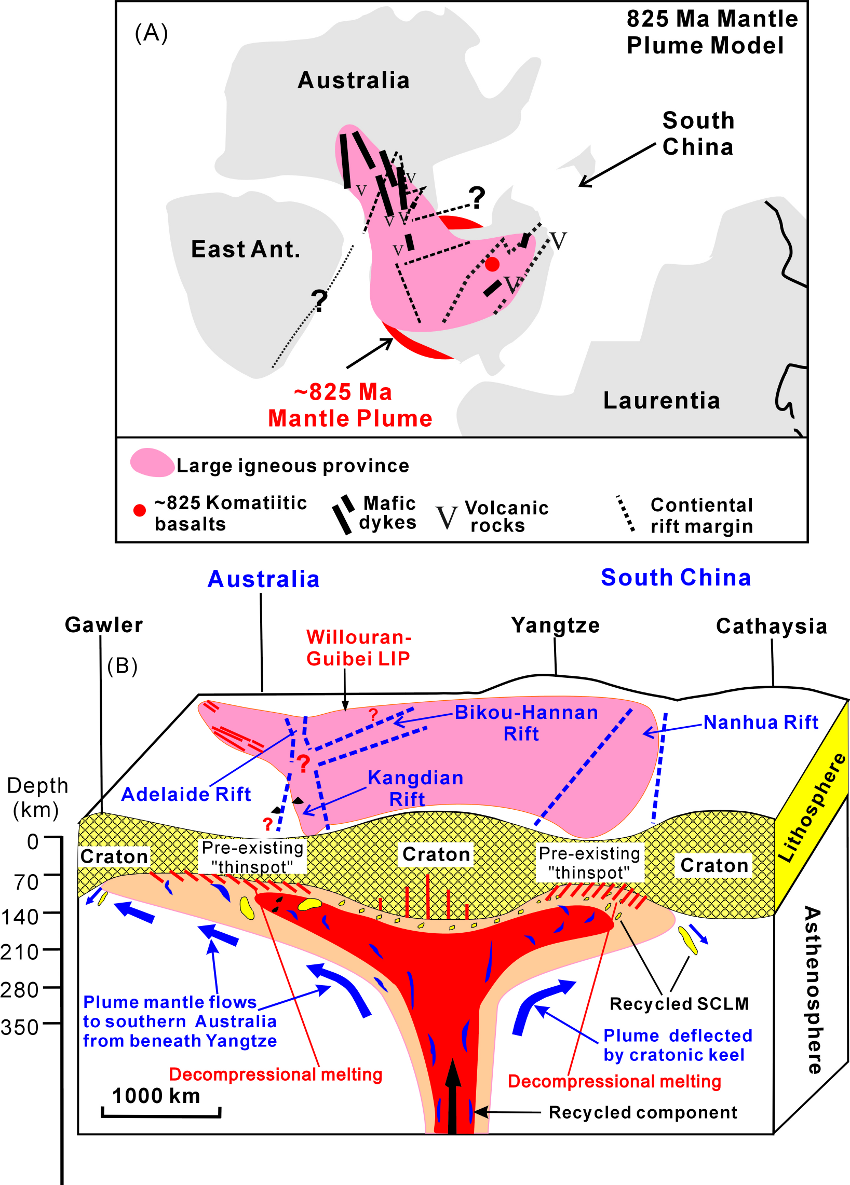
Figure 8. (A) Distribution of the proposed single large igneous province in the Rodinia reconstruction of Li et al. (2008). (B) Cartoon diagram showing the proposed model for the genesis of the large igneous province including the Nanhua, Kangdian, Bikou-Hannan, and Adelaide rift systems (after Wang et al., 2010a).
References
Crawford, A.J., Hilyard, D., 1990. Geochemistry of late Proterozoic tholeiitic flood basalts, Adelaide Geosyncline, South Australia. In: Jago, J.B. and Moore, P.S. (Eds.), The evolution of a Late Precambrian-Early Palaeozoic rift complex: The Adelaide Geosyncline. Geological Society of Australia Special Publication 16, 49-67.
Ernst, R.E., Wingate, M.T.D., Buchan, K.L. and Li, Z.X., 2008. Global record of 1600-700Ma Large Igneous Provinces (LIPs): Implications for the reconstruction of the proposed Nuna (Columbia) and Rodinia supercontinents. Precambrian Research, 160: 159-178.
Fanning, C.M., Ludwig, K.R., Forbes, B.G., Preiss, W.V., 1986. Single and multiple grain U–Pb zircon analyses for the early Adelaidean Rook Tuff, Willouran Ranges, South Australia. Abstracts/Geological Society of Australia 15, 71-72.
Foden, J., Song, S.H., Tuner, S., Elburg, M., Smith, P.B., Steldt, B.V., Penglis, B.V., 2002. Geochemical evolution of lithospheric mantle beneath S.E. South Australia. Chemical Geology 182, 663-695.
Hilyard, D., 1990. Willouran Basic Province: Stratigraphy of Late Proterozoic flood basalts, Adelaide Geosyncline, South Australia. In: Jago, J.B. and Moore, P.S. (Eds.), The evolution of a Late Precambrian-Early Palaeozoic rift complex: The Adelaide Geosyncline. Geological Society of Australia Special Publication 16, 34-48.
Li, X.H., Li, Z.X., Sinclair, J.A., Li, W.X., Carter, G., 2007. Reply to the comment by Zhou et al. on: “Revisiting the “Yanbian Terrane”: Implications for Neoproterozoic tectonic evolution of the western Yangtze Block, South China”. Precambrian Research, 155, 318-323.
Li, X.H., Li, Z.X., Sinclair, J.A., Li, W.X., Carter, G., 2006. Revisiting the “Yanbian Terrane”: implications for Neoproterozoic tectonic evolution of the western Yangtze Block, South China. Precambrian Research 151, 14-30
Li, X.H., Li, Z.X., Ge, W.C., Zhou, H.W., Li, W.X., Liu, Y. and Wingate, M.T.D., 2003a. Neoproterozoic granitoids in South China: crustal melting above a mantle plume at ca. 825 Ma? Precambrian Research, 122(1-4): 45-83.
Li, X.H., Li, Z.X., Zhou, H.W., Liu, Y. and Kinny, P.D., 2002. U-Pb zircon geochronology, geochemistry and Nd isotopic study of Neoproterozoic bimodal volcanic rocks in the Kangdian Rift of South China: implications for the initial rifting of Rodinia. Precambrian Research, 113(1-2): 135-154.
Li, Z.X., Li, X.H. and Wang, X.C., 2009. The South China piece in the Rodinian puzzle: A reply to the comment by Munteanu and Wilson. Precambrian Research 171, 77-79.
Li, Z.X. and Zhong, S., 2009. Supercontinent-superplume coupling, true polar wander and plume mobility: Plate dominance in whole-mantle tectonics. Physics of the Earth and Planetary Interiors, 176(3-4): 143-156.
Li, Z.X., Bogdanova, S.V., Collins, A.S., Davidson, A., De Waele, B., Ernst, R.E., Fitzsimons, I.C.W., Fuck, R.A., Gladkochub, D.P., Jacobs, J., Karlstrom, K.E., Lu, S., Natapov, L.M., Pease, V., Pisarevsky, S.A., Thrane, K. and Vernikovsky, V., 2008. Assembly, configuration, and break-up history of Rodinia: A synthesis. Precambrian Research 160, 179-210.
Li, Z.X., Li, X.H., Kinny, P.D., Wang, J., Zhang, S. and Zhou, H., 2003b. Geochronology of Neoproterozoic syn-rift magmatism in the Yangtze Craton, South China and correlations with other continents: evidence for a mantle superplume that broke up Rodinia. Precambrian Research 122, 85-109.
Li, Z.X., Li, X.H., Kinny, P.D. and Wang, J., 1999. The breakup of Rodinia: did it start with a mantle plume beneath South China? Earth and Planetary Science Letters, 173(3): 171-181.
Li, Z.X., Zhang, L. and Powell, C.M., 1995. South China in Rodinia: part of the missing link between Australia–East Antarctica and Laurentia? Geology, 23: 407-410.
Park, J.K., Buchan, K.L. and Harlan, S.S., 1995. A proposed giant radiating dyke swarm fragmented by the separation of Laurentia and Australia based on paleomagnetism of ca. 780 Ma mafic intrusions in western North America. Earth and Planetary Science Letters, 132(1-4): 129-139.
Preiss, W.V., 2000. The Adelaide Geosyncline of South Australia and its significance in Neoproterozoic continental reconstruction. Precambrian Research 100, 21-63.
Wang, Q., Wyman, D.A., Li, Z.X., Bao, Z.W., Zhao, Z.H., Wang, Y.X., Jian, P., Yang, Y.H., Chen, L.L., 2010b. Petrology, geochronology and geochemistry of ca. 780 Ma A-type granites in South China: Petrogenesis and implications for crustal growth during the breakup of the supercontinent Rodinia. Precambrian Research 178, 185-208.
Wang,X.C., Li,X.H., Li,Z.X., Liu,Y.,2010a. The Willouran Basic Province of South Australia: its relation to the Guibei Large Igneous Province in South China and the breakup of Rodinia. Lithos (accpeted).
Wang, X.C., Li, X.H., Li, W.X. and Li, Z.X., 2009. Variable involvements of mantle plumes in the genesis of mid-Neoproterozoic basaltic rocks in South China: A review. Gondwana Research, 15: 381-395.
Wang, X.C., Li, X.H., Li, W.X., Li, Z.X., Liu, Y., Yang, Y.H., Liang, X., R., Tu, X.L., 2008. The Bikou basalts in northwestern Yangtze Block, South China: Remains of 820-810 Ma continental flood basalts? Geological Society of American Bulletin 120, 1478-1492.
Wang, X.C., Li, X.-H., Li, W.-X. and Li, Z.-X., 2007. Ca. 825 Ma komatiitic basalts in South China: First evidence for >1500 oC mantle melts by a Rodinian mantle plume. Geology, 35(12): 1103-1106.
Wingate, M.T.D., Campbell, I.H., Compston, W. and Gibson, G.M., 1998. Ion microprobe U-Pb ages for Neoproterozoic basaltic magmatism in south-central Australia and implications for the breakup of Rodinia. Precambrian Research, 87: 135-159.
Zhao, J.X., McCulloch, M.T. and Korsch, R.J., 1994. Characterisation of a plume-related ~ 800 Ma magmatic event and its implications for basin formation in central-southern Australia. Earth and Planetary Science Letters, 121(3-4): 349-367.
Zhou, M.F., Ma, Y.X., Yan, D.P., Xia, X.P., Zhao, J.H., Sun, M., 2006. The Yanbian Terrane (Southern Sichuan Province, SW China): a late proterozoic arc assemblage in the western margin of the Yangtze Block. Precambrian Research 144, 19-38.
Zhou, M., Kennedy, A.K., Sun, M., Malpas, J., Lesher, C.M., 2002. Neoproterozoic arc-related mafic intrusions along the northern margin of South China; implications for the accretion of Rodinia. Journal of Geology 110, 611-618.
